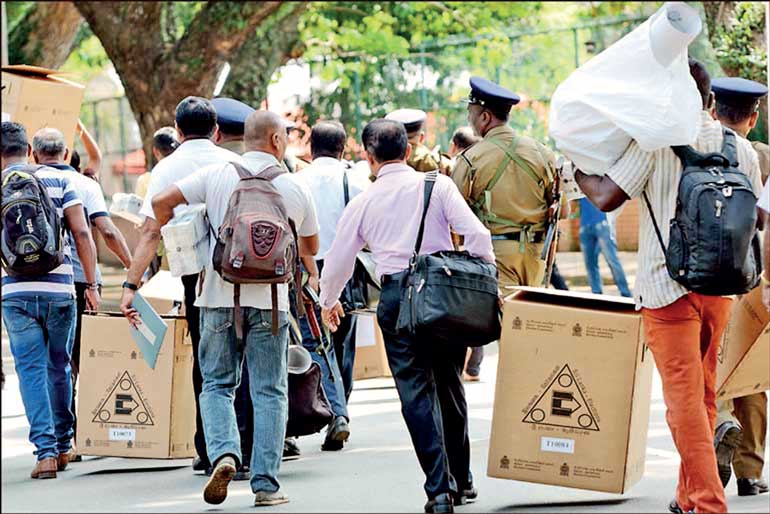Thursday Apr 24, 2025
Thursday Apr 24, 2025
Wednesday, 11 September 2024 00:22 - - {{hitsCtrl.values.hits}}

The 2024 Presidential election will likely be the first time in Sri Lanka’s election history that a candidate who does not receive 50% of the valid votes is elected president – Pic by Shehan Gunasekara
 This month, Sri Lankans will be casting their ballot for a new president. However, the 2024 Presidential election faces an unusual challenge. Conventionally, elections have featured two primary candidates contesting each other. In 2019, it was Gotabaya Rajapaksa versus Sajith Premadasa; in 2015, it was Maithripala Sirisena versus Mahinda Rajapaksa; in 2010, it was Mahinda Rajapaksa versus Sarath Fonseka. At each of these elections, the winning candidate secured more than 50% of the valid votes. According to article 94(2) of the Constitution, ‘The candidate, if any, who receives more than one-half of the valid votes cast shall be declared elected as President.’
This month, Sri Lankans will be casting their ballot for a new president. However, the 2024 Presidential election faces an unusual challenge. Conventionally, elections have featured two primary candidates contesting each other. In 2019, it was Gotabaya Rajapaksa versus Sajith Premadasa; in 2015, it was Maithripala Sirisena versus Mahinda Rajapaksa; in 2010, it was Mahinda Rajapaksa versus Sarath Fonseka. At each of these elections, the winning candidate secured more than 50% of the valid votes. According to article 94(2) of the Constitution, ‘The candidate, if any, who receives more than one-half of the valid votes cast shall be declared elected as President.’
But what if no candidate gets more than one half of the valid votes?
According to article 94(1)(b) of the Constitution, where there are more than three candidates, each voter may specify their second and third preferences. Then, if no candidate gets more than one half of the valid votes, the procedure set out in article 94(3) of the Constitution applies:
Where no candidate is declared elected under paragraph (2) of this Article, the candidate or candidates other than the candidates who received the highest and second highest number of such votes, shall be eliminated from the contest, and –
a) The second preference of each voter whose vote had been for a candidate eliminated from the contest, shall if it is for one of the other of the remaining two candidates, be counted as a vote for such candidate and be added to the votes counted in his favour under paragraph (2), and
b) The third preference of each voter referred to in sub-paragraph (a) whose second preference is not counted under that subparagraph shall, if it is for one or the other of the remaining two candidates, be counted as a vote for such candidate and be added to the votes counted in his favour under subparagraph (a) and paragraph (2),
Imagine V, W, X, Y and Z are presidential candidates competing against each other. A, B, C, D, and E are five of the voters. Candidate X gets 31% of the valid votes — the highest percentage of votes by any single candidate. Candidate Y gets 29% of the votes, candidate Z gets 20% and candidates V and W get 10% each. Although candidate X got the highest percentage of votes, they cannot immediately be elected president, as they have received less than 50% of the valid votes. The Constitution requires the second and third preferences of voters who voted for Z, V, and W to then be counted. The first, second and third preferences of the voters are as follows:
A — Y, X, Z
B — X, Y, W
C — W, Y, Z
D — V, Z, Y
E — Z, W, V
According to the procedure set out in article 94(3) of the Constitution, all candidates except the top two candidates (X and Y) will be eliminated from the contest and there will be a second count. Thus, Z, V, and W will be eliminated. The results of this second count will be added to X and Y’s existing tally. This second count will exclude all the voters who marked X and Y as their first preference. Therefore, A and B’s votes will be excluded. C has marked W as their first preference and Y as their second preference. Therefore, C’s vote will be counted as a vote for Y. D has marked V as their first preference and Z as their second preference. Since both V and Z have been eliminated, D’s third preference will be taken into consideration. Given that D has marked Y as their third preference, D’s vote will be counted as a vote for Y. Since E has not given X or Y any preference E’s vote will not be counted in the second count.
When a second count is carried out, article 94(3) provides that ‘the candidate who receives the majority of the votes so counted shall be declared elected as President’. For instance, if Y happens to get a significant number of second and third preferences, and thus receives 32% of the valid votes when such preferences are accounted for, Y will win the election. In such a scenario, the president would not be the recipient of more than 50% of the valid votes but would instead be the candidate with the highest number of valid votes including the second and third preferences of certain voters.
The 2024 Presidential election will likely be the first time in Sri Lanka’s election history that a candidate who does not receive 50% of the valid votes is elected president.
(The writer is an attorney-at-law and a Junior Associate at LexAG — Legal Consultants.)
Discover Kapruka, the leading online shopping platform in Sri Lanka, where you can conveniently send Gifts and Flowers to your loved ones for any event including Valentine ’s Day. Explore a wide range of popular Shopping Categories on Kapruka, including Toys, Groceries, Electronics, Birthday Cakes, Fruits, Chocolates, Flower Bouquets, Clothing, Watches, Lingerie, Gift Sets and Jewellery. Also if you’re interested in selling with Kapruka, Partner Central by Kapruka is the best solution to start with. Moreover, through Kapruka Global Shop, you can also enjoy the convenience of purchasing products from renowned platforms like Amazon and eBay and have them delivered to Sri Lanka.
Discover Kapruka, the leading online shopping platform in Sri Lanka, where you can conveniently send Gifts and Flowers to your loved ones for any event including Valentine ’s Day. Explore a wide range of popular Shopping Categories on Kapruka, including Toys, Groceries, Electronics, Birthday Cakes, Fruits, Chocolates, Flower Bouquets, Clothing, Watches, Lingerie, Gift Sets and Jewellery. Also if you’re interested in selling with Kapruka, Partner Central by Kapruka is the best solution to start with. Moreover, through Kapruka Global Shop, you can also enjoy the convenience of purchasing products from renowned platforms like Amazon and eBay and have them delivered to Sri Lanka.